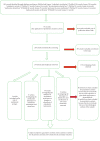Management of Instrument Sterilization Workflow in Endodontics: A Systematic Review and Meta-Analysis
- PMID: 32148504
- PMCID: PMC7035513
- DOI: 10.1155/2020/5824369
Management of Instrument Sterilization Workflow in Endodontics: A Systematic Review and Meta-Analysis
Abstract
Endodontic treatment consists of different working procedures, such as the isolation of the operating field, pulp chamber access, and cleaning and shaping phases with at last the need of a three-dimensional filling of the canals. Each step requires a series of single-use or sterilizable instruments. We have performed a systematic review of different sterilization and disinfection procedures aiming at drawing up a disinfection and sterilization procedure to be used on endodontic instruments. A search on PubMed and Scopus was carried out using the following keywords: "endodontic sterilization," "endodontic autoclave," "decontamination dental bur," "sterilization dental burs," and "gutta-percha points sterilization." Eligible articles were included in the qualitative and quantitative analysis. Results of the meta-analysis showed that the most effective method in sterilization is autoclaving. The qualitative analysis showed that the use of single-use or first-use instruments requires presterilization or sterilization procedures, and for reusable tools, attention must be paid to the removal of debris deposited on the blades, not easy to remove manually.
Copyright © 2020 Mario Dioguardi et al.
Conflict of interest statement
The authors declare no conflicts of interest.
Figures




Similar articles
-
The Effects of Sterilization Procedures on the Cutting Efficiency of Endodontic Instruments: A Systematic Review and Network Meta-Analysis.Materials (Basel). 2021 Mar 22;14(6):1559. doi: 10.3390/ma14061559. Materials (Basel). 2021. PMID: 33810097 Free PMC article. Review.
-
Effects of Hot Sterilization on Torsional Properties of Endodontic Instruments: Systematic Review with Meta-Analysis.Materials (Basel). 2019 Jul 8;12(13):2190. doi: 10.3390/ma12132190. Materials (Basel). 2019. PMID: 31288384 Free PMC article. Review.
-
Pathological evaluation for sterilization of routinely used prosthodontic and endodontic instruments.J Int Soc Prev Community Dent. 2015 May-Jun;5(3):232-6. doi: 10.4103/2231-0762.159962. J Int Soc Prev Community Dent. 2015. PMID: 26236684 Free PMC article.
-
Evaluation of biological debris on endodontic instruments after cleaning and sterilization procedures.Int Endod J. 2010 Apr;43(4):336-41. doi: 10.1111/j.1365-2591.2010.01686.x. Int Endod J. 2010. PMID: 20487454
-
Dental burs and endodontic files: are routine sterilization procedures effective?Tex Dent J. 2010 Mar;127(3):295-300. Tex Dent J. 2010. PMID: 20391948
Cited by
-
A Comparative In-Vitro Study of the Effectiveness of Several Methods of Sterilizing Endodontic Files.Cureus. 2024 Nov 26;16(11):e74473. doi: 10.7759/cureus.74473. eCollection 2024 Nov. Cureus. 2024. PMID: 39726458 Free PMC article.
-
The Effects of Sterilization Procedures on the Cutting Efficiency of Endodontic Instruments: A Systematic Review and Network Meta-Analysis.Materials (Basel). 2021 Mar 22;14(6):1559. doi: 10.3390/ma14061559. Materials (Basel). 2021. PMID: 33810097 Free PMC article. Review.
-
Quantitative Evaluation of Debris Removal from NiTi Rotary Endodontic Instruments After Different Cleaning Procedures.Dent J (Basel). 2025 Jan 23;13(2):49. doi: 10.3390/dj13020049. Dent J (Basel). 2025. PMID: 39996923 Free PMC article.
-
Effect of autoclave sterilization on the cyclic fatigue resistance of EdgeFile X7, 2Shape, and F-one nickel-titanium endodontic instruments.J Conserv Dent. 2023 Jan-Feb;26(1):26-30. doi: 10.4103/jcd.jcd_611_21. Epub 2022 Aug 17. J Conserv Dent. 2023. PMID: 36908740 Free PMC article.
-
Expert consensus on management of instrument separation in root canal therapy.Int J Oral Sci. 2025 Jun 9;17(1):46. doi: 10.1038/s41368-025-00372-w. Int J Oral Sci. 2025. PMID: 40484859 Free PMC article. Review.
References
Publication types
LinkOut - more resources
Full Text Sources

